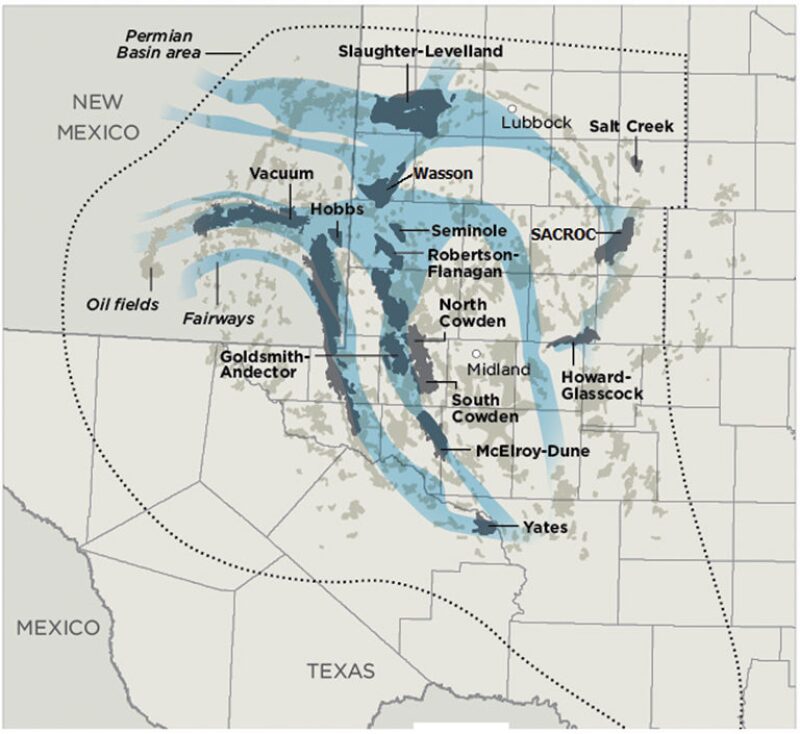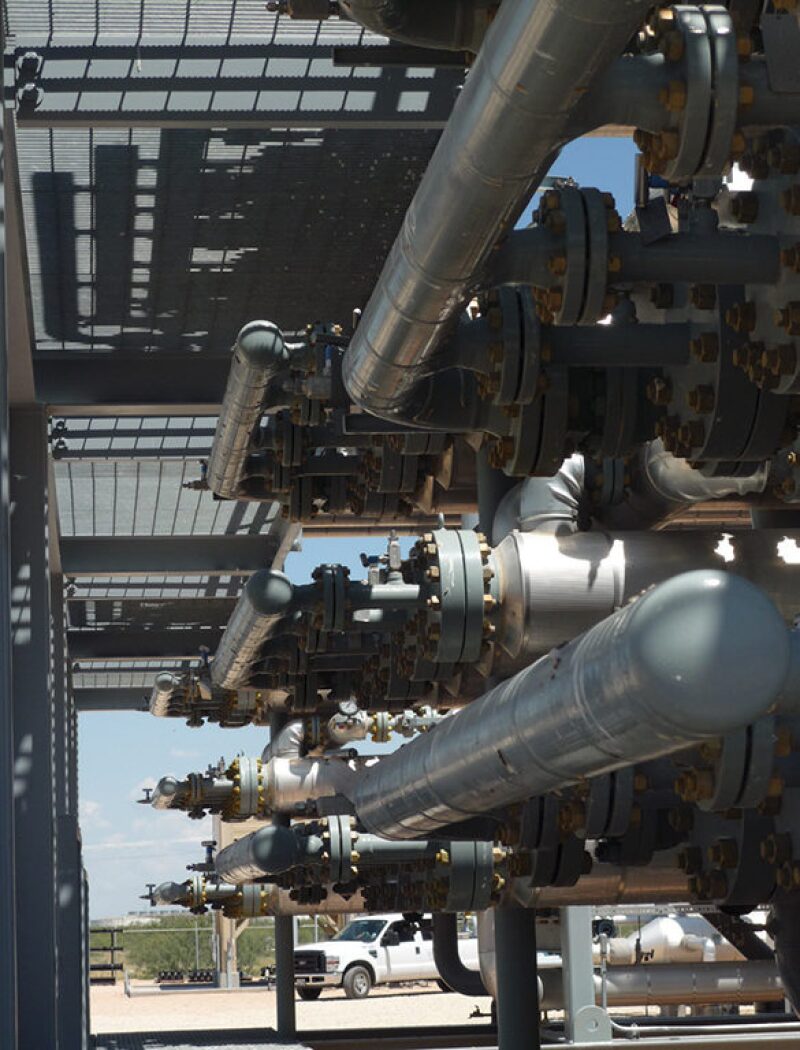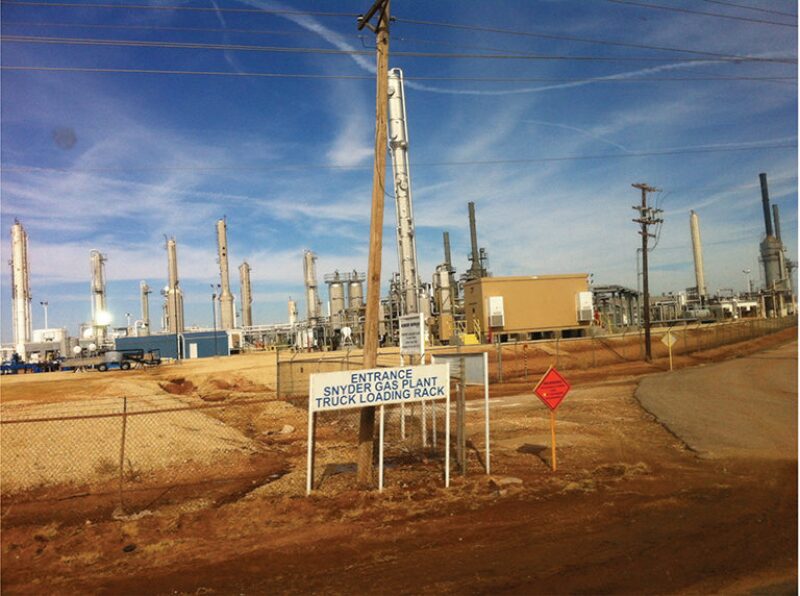Carbon dioxide (CO2) injected into oil fields is “the gift that keeps giving.” The description comes from David Schechter, an associate professor of petroleum engineering at Texas A&M University, who is researching whether CO2 can be used to coax billions more barrels of oil from unconventional formations.
In the United States, 318,000 B/D of oil production is credited to the injection of 3,443 billion ft3 of carbon dioxide. That estimate is based on a joint study by the US Department of Energy (DOE) and the University of Wyoming, which forecast that this technique for enhancing oil production could nearly double by 2018. That assumes a surge in the amount of CO2 captured from industrial sources to meet the growing demand.
Offshore Brazil, carbon dioxide removed from natural gas produced in the Lula field is being reinjected into that reservoir to reduce carbon emissions. It offers a rare test for learning how injecting CO2 affects the output of a young field, and Petrobras has said reinjection will be applied to other large offshore fields.
A growing body of evidence indicates that below the aging giant oil reservoirs in west Texas, is a large untapped layer known as the residual oil zone (ROZ) that could produce billions of barrels if enough CO2 is available to coax crude out of formations with low oil saturations.
Some people working to find ways to reduce CO2 emissions see selling CO2 to increase oil production as one of the only currently available methods to financially justify capturing the gas blamed for global warming and store it.
The growth potential is strong if a lot more carbon dioxide is available at the right price. “The biggest problem with carbon dioxide is there is not enough of it. There are far more projects than carbon dioxide,” said David Vance, a geologist who is a principal scientist at Arcadis. Vance moved a decade ago to Midland, Texas, to become part of a community of people there who are focused on turning what is still seen as a west Texas thing into something far larger.
The nature of that vision is on display annually at the CO2 Flooding Conference and at its sister event, the EOR Carbon Management Workshop, both held during the same week in December 2013 in Midland, Texas. The pair of meetings, which go back more than a decade, is evidence of the marriage of necessity that has sprung up between those who see CO2 as a means to greater oil production and those who see oil reservoirs as the only growing option now for long-term CO2 storage. As with many things related to CO2 EOR, the relationship is complicated.
Europe’s grand plan to pay to store carbon dioxide as a waste product in saline aquifers sunk with the carbon credit market, where the cost of buying the right to emit CO2 has dropped to around USD 5.50/t, far less than the cost of pumping it into a deep aquifer forever. Those using CO2 to enhance oil production will pay far more for the gas, giving them a strong motivation to ensure a valuable commodity does not escape into the atmosphere.
At the Midland conference, speakers played up how CO2 EOR can be used to pay for carbon capture, utilization, and storage (CCUS). It is a positive environmental message, but convincing environmental regulators that injected carbon dioxide will remain stored in the ground permanently, is a problem to be solved.
The US Environmental Protection Agency has developed a permitting process for long-term CO2 storage (Class VI), which is likely to be needed for facilities capturing CO2 to meet emission limits on the gas. To do that, they will need to prove it has been secured in an underground formation where it will remain.
But operators fear large added costs and long-term liabilities if the agency requires a mass migration by those conducting CO2 EOR using a Class II permit to the new standard, said Michael Moore, executive director of the North American Carbon Capture and Storage Association and the organizer of the EOR Carbon Management Workshop.
On the supply side, the US government is supporting the search for greater supplies. The US Geological Survey (USGS) is working on its first national survey of technically available natural CO2 resources, said Peter Warwick, research geologist at the USGS. It recently completed a survey of CO2 storage space in the US. What it found suggested underground capacity is not likely to limit storage.

The US DOE is backing research into potential sources of manmade CO2 and supporting industrial installations to demonstrate that it can be captured in industrial plants. It is also backing research to increase the effectiveness of CO2 EOR.
Gas supplies from industrial facilities are expected to rise from fivefold to sevenfold over the next 5 years.
“CO2 is a nice business that is going along well. But, now we are starting to think about the next phase of CO2‑driven production, and we do not have the CO2 to do that,” said Chuck McConnell, executive director of the Energy and the Environment Initiative at Rice University and former assistant secretary of energy for fossil energy at the US DOE. He said, “Punching more holes in the ground is not the strategy for the next phase of the CO2 business.”
The USD 40 Limit
There is a giant supply of manmade carbon dioxide, but much of what comes out of smokestacks is mixed with other gases such as nitrogen, noxious chemicals such as mercury, and particles of soot.
The cost of extracting pure CO2 from that mix using current technology typically exceeds what the oil industry is willing to pay. That challenge was summed by one long-term attendee to the CO2 conference, who said the message offered every year is “Carbon dioxide works. We need more of it. And we are not going to pay more than USD 40 a ton.”
The creator of the conference, Steve Melzer, founder of Melzer Consulting, said those three themes are a given but he is seeing signs of significant change.
The use of manmade (anthropogenic) CO2 is expected to increase fivefold by 2020, according to Vello Kuuskraa, president of Advanced Resources International, who presented its region-by-region analysis of CO2 use at the conference. By 2020, gas from industrial sources will nearly equal the supply from natural ones, he said.
Every North American region he looked at is expected to grow rapidly in terms of CO2 use and production. The traditional center of the business remains the Permian Basin in west Texas, but that area’s dominant position in CO2 EOR is expected to erode as others grow faster.
By far the largest expansion is expected on the US Gulf Coast, where low-cost US natural gas is stoking a rapid expansion of petrochemical plants capable of also producing CO2 for sale.
Supply growth could allow CO2 EOR to move offshore in the US. That could start in the shallow waters of the Gulf of Mexico, where little-used natural gas lines might offer a low-cost supply route; but, the big prize is in the deep waters of the US Gulf of Mexico, Kuuskraa said.
The predicted sources of supply vary by region. Industrial supplies are critical in the midcontinent, while drilling in the Rockies could increase production from CO2 fields there. If a large liquefied national gas plant is built in Alaska to export natural gas from the North Slope, the CO2 removed during chilling could be used for enhanced oil projects there.
“There are distinct systems for carbon dioxide, and in all of them is a lot of expected growth,” Kuuskraa said. But, in some of those areas where he sees growth, such as offshore, there is a cost gap, he said.
Puzzles to Solve
The man who started the conference is at the center of the international network of those interested in CO2 EOR. An engineer at the meeting in need of names for some market research prefaced his request to Melzer by saying, “you are the guy who knows everybody in the business.”
That is a testimony to the 19 years Melzer has been at this, and to the relatively small size of this community. For now, what they are doing looks tiny compared with the boom in unconventional exploration.
Those visiting Midland for the meeting could see how its landscape was being altered by new offices and equipment yards for companies racing to develop the enormous unconventional shale oil formations nearby in the Permian Basin, such as the Wolfcamp shale.
“The shale guys are winning the investment dollars now,” said Doug McMurrey, vice president of marketing and business development for Kinder Morgan CO2. In the Permian Basin, CO2 EOR is competing with shale plays, such as the Wolfcamp, which appeals to investors who prefer projects that break even sooner rather than later.

When oil prices are around USD 100/bbl, the Wolfcamp can offer relatively fast paybacks, despite the high cost of drilling and completing those wells. Those involved in CO2 EOR counter that a well-run project can produce oil for less per barrel than shale and return equal or better profit margins. But it takes years longer to deliver those returns and an operator with the knowledge and experience needed to manage the complex process of alternating between CO2 injection and waterflooding. While shale well production quickly declines, CO2 EOR can provide a return on investment for many years to come, McMurrey said.
Tabula Rasa Partners, a young company in CO2 EOR with private equity financing, has bought CO2 reserves and is working on four CO2 flooding projects in west Texas. “We feel it is important that we have a foot in both the CO2 and the EOR worlds. What we find is there are a lot of opportunities out there,” said Tracy Evans, chief operator officer at Tabula Rasa, who previously filled a similar position at Denbury Resources, one of the largest operators in CO2 supply and EOR.

Evans said CO2 EOR developers need to seek out long-term investors. And he said production generated using CO2 is better understood than the long-term outlook for production from shale formations. “The risk-adjusted rate of return on EOR is as attractive as shale,” Evans said. And Tabula Rasa’s goals include exploring a frontier with some significant upside—the ROZ.
Next Generation
For those in carbon dioxide injection, the ROZ has been their moonshot. This zone, which is also called the transition zone, lies below the main pay zones that once held far higher concentrations of oil. The ROZ looks appealing now because it can be up to 400 ft thick and the oil found in it (20% to 40% saturation) is comparable to what is left in the main pay zones after decades of production.
Operators are beginning to explore the ROZ, hoping deeper wells into the zone can extend the life of old fields. In the process, they are testing whether the ROZ extends beyond the limits of the fields.
The Seminole San Andres Unit, operated by Hess, was redeveloped to tap the ROZ. In a presentation at the conference, Hess said it has 30 injection and production wells in the ROZ and 80 in the main pay zone. It deepened some wells to limit the cost of new drilling and injected only CO2 for 2 years in the ROZ.
Results of the project were described as positive. When asked for ROZ production numbers, Chad McGehee, team lead for well servicing at Hess, said determining production by zone is difficult because CO2 travels vertically from one to another, adding that the company does not disclose such detailed production information.
However, he did say that the ROZ there extends beyond the boundaries of the Seminole. That comment supports the theory that the residual oil zone exists well beyond the boundaries of the fields. Those working on ROZ research describe it as Mother Nature’s waterflood because they say the aquifer moving at approximately 1 ft every 1000 years ultimately swept much of the oil out of the thick reservoir, leaving behind a permeable carbonate reservoir with a low oil saturation—20 to 40%—comparable to what remains in the primary production zone above it after decades of waterflooding.
If that is so, it could offer a new frontier for production between fields using CO2 EOR. The US DOE has backed a study by a team associated with the University of Texas of the Permian Basin, led by Melzer, to study the ROZ and create reservoir-modeling tools to understand it better and produce oil from it.
Melzer’s current best estimate is 28 billion bbl in the ROZ beneath conventional reservoirs in the Permian—called brownfield ROZ. “If we are good at what we do, we can get one-third of it,” Melzer said. They are now working on an estimate of the total resource in the Permian, but the potential in the large areas between fields looks huge. It is difficult to pin down because no one has ever drilled a successful well in what is known as the greenfield ROZ. Melzer said that could double or triple the total resource.
And the ROZ may well be found in other regions because the geological factors found in the Permian are found in other oil-producing regions, such as the Rockies. Given the amount of CO2 needed, they would ideally be located near large industrial sources of CO2.
It is a vision that has entailed years of work mapping the ROZ from data from past projects that looked at, and often drilled through, the zone. Melzer hopes to see greenfield ROZ drilling in the next few years. As with many things to do with ROZ, it is a complicated pursuit that will depend on finding more carbon dioxide.
“It will inevitably have a lot of moving parts when selling and financing a project,” Melzer said. It will require “getting engineers to speak the same language as financial people and vice versa.”
“An awful lot of stuff we do relies on multiple processes and finding markets for a couple products,” he said. “If we can bridge that gap, we can see large volumes (of CO2) come into the market.”


